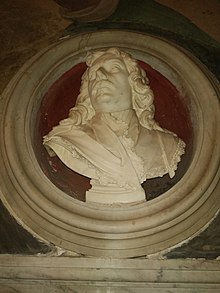
Luigi Mattei (died 1665) was an Italian military General [1] and Marquis de Belmonte. During the 17th century he commanded troops loyal to the papal armies of Barberini Pope Urban VIII and Pamphili Pope Innocent X during the Wars of Castro. [2]

Luigi Mattei (died 1665) was an Italian military General [1] and Marquis de Belmonte. During the 17th century he commanded troops loyal to the papal armies of Barberini Pope Urban VIII and Pamphili Pope Innocent X during the Wars of Castro. [2]
Mattei was the second son of Asdrubale Mattei, Marquis di Giove, of the House of Mattei and his wife Costanza Gonzaga of the House of Gonzaga. [3] His older brother, Girolamo Mattei, became Duca di Giove. He was the nephew of Ciriaco Mattei and Cardinal Girolamo Mattei.
He is variously described as Baron Mattei, a Papal Marquis and Papal Army Field Marshal . [4] It is more likely, though, that he was simply a skilled military leader (militia leader) loyal to the papacy of Pope Urban VIII and then later Pope Innocent X.
During the late 1630s, Pope Urban and his Barberini nephews came into conflict with the Farnese Dukes of Parma sparking the conflict known as the First War of Castro. In 1641, Mattei was appointed Lieutenant General of the papal armies and was accordingly given a monthly salary of 343 scudi. [5] On 12 October he led 12,000 infantry and 3,000 cavalry against the fortified town of Castro which was under the control of the Farnese. Though it is estimated that the Farnese had amassed a similarly sized army, [5] Mattei's forces were met with very little resistance and the town was forced to surrender. Mattei's victory at Castro was immortalised in song by Marco Marazzoli.[ citation needed ]
Evidence suggests that Mattei commanded his own private standing army (much smaller without additional Papal soldiers) of approximately 4000 troops. [6] After the initial contact with Farnese troops, Mattei's soldiers left the bulk of the papal army and followed him. They were involved in further skirmishes while remaining Papal troops returned to defend Rome. [7] Papal and Barberini forces suffered a number of decisive defeats and Pope Urban was eventually forced to agree to treaty terms with the Farnese to halt the conflict.[ citation needed ]
When Ranuccio II Farnese refused to pay the debts assigned to him in the treaty that ended the First War of Castro, Pope Innocent X sent a force to again occupy the city. The Duke rode out to challenge the papal forces but was routed by Mattei. [8] Forces loyal to Innocent X razed Castro and it was never rebuilt. Thus ended the Second War of Castro.
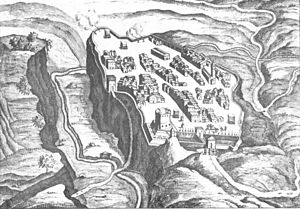

Pope Urban VIII, born Maffeo Vincenzo Barberini, was head of the Catholic Church and ruler of the Papal States from 6 August 1623 to his death, in July 1644. As pope, he expanded the papal territory by force of arms and advantageous politicking, and was also a prominent patron of the arts and a reformer of Church missions.

Pope Innocent X, born Giovanni Battista Pamphilj, was head of the Catholic Church and ruler of the Papal States from 15 September 1644 to his death, in January 1655.

Ranuccio II Farnese was the sixth Duke of Parma and Piacenza from 1646 until his death nearly 50 years later and Duke of Castro from 1646 until 1649.
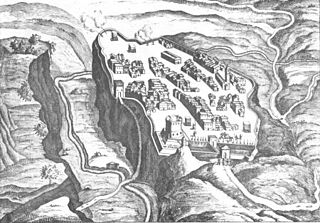
Castro was an ancient city on the west side of Lake Bolsena in the present-day comune of Ischia di Castro, northern Lazio, Italy. It was destroyed at the conclusion of the Wars of Castro in the 17th century.

The Wars of Castro were a series of conflicts during the mid-17th century revolving around the ancient city of Castro, which eventually resulted in the city's destruction on 2 September 1649. The conflict was a result of a power struggle between the papacy – represented by members of two deeply entrenched Roman families and their popes, the Barberini and Pope Urban VIII and the Pamphili and Pope Innocent X – and the Farnese dukes of Parma, who controlled Castro and its surrounding territories as the Duchy of Castro.

The House of Farnese was an influential family in Renaissance Italy. The titles of Duke of Parma and Piacenza and Duke of Castro were held by various members of the family.
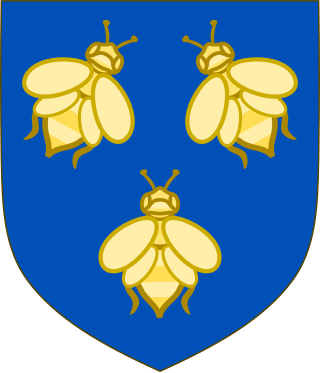
The House of Barberini is a family of the Italian nobility that rose to prominence in the 17th century Rome. Their influence peaked with the election of Cardinal Maffeo Barberini to the papal throne in 1623, as Pope Urban VIII. Their urban palace, the Palazzo Barberini, completed in 1633 by Bernini, today houses Italy's Galleria Nazionale d'Arte Antica.
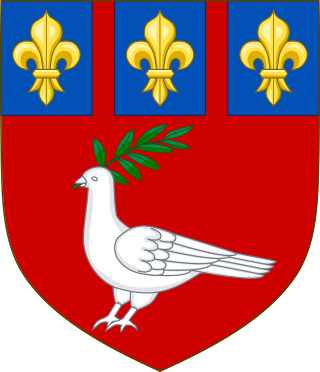
The House of Pamphili was one of the papal families deeply entrenched in Catholic Church, Roman and Italian politics of the 16th and 17th centuries.
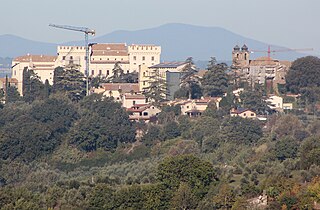
Giove is a comune in the province of Terni.

The House of Mattei was one of the most powerful noble families of Rome during the Middle Ages and early modern era, holding high positions in the papal curia and government office. The family amassed significant art collections under art enthusiasts such as Ciriaco Mattei.

Antonio Barberini was an Italian Catholic cardinal, Archbishop of Reims, military leader, patron of the arts and a prominent member of the House of Barberini. As one of the cardinal-nephews of Pope Urban VIII and a supporter of France, he played a significant role at a number of the papal conclaves of the 17th century. With his brothers Cardinal Francesco Barberini and Taddeo Barberini he helped to shape politics, religion, art and music of 17th century Italy. He is sometimes referred to as Antonio the Younger or Antonio Barberini iuniore to distinguish him from his uncle Antonio Marcello Barberini.

The Diocese of Frascati is a Latin suburbicarian see of the Diocese of Rome and a diocese of the Catholic Church in Italy, based at Frascati, near Rome. The bishop of Frascati is a Cardinal Bishop; from the Latin name of the area, the bishop has also been called Bishop of Tusculum. Tusculum was destroyed in 1191. The bishopric moved from Tusculum to Frascati, a nearby town which is first mentioned in the pontificate of Pope Leo IV. Until 1962, the Cardinal-Bishop was concurrently the diocesan bishop of the see. Pope John XXIII removed the Cardinal Bishops from any actual responsibility in their suburbicarian dioceses and made the title purely honorific.

A crown-cardinal was a cardinal protector of a Roman Catholic nation, nominated or funded by a Catholic monarch to serve as their representative within the College of Cardinals and, on occasion, to exercise the right claimed by some monarchs to veto a candidate for election to the papacy. More generally, the term may refer to any cardinal significant as a secular statesman or elevated at the request of a monarch.

Taddeo Barberini (1603–1647) was an Italian nobleman of the House of Barberini who became Prince of Palestrina and Gonfalonier of the Church; commander of the Papal Army. He was a nephew of Pope Urban VIII and brother of Cardinals Francesco Barberini and Antonio Barberini. Thanks to their uncle's famous nepotism, the brothers shaped 17th-century Italian politics, religion, art, music and architecture.
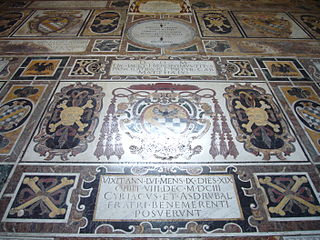
Girolamo Mattei was an Italian Cardinal from the House of Mattei.
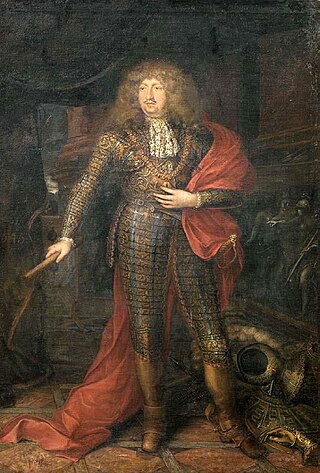
Maffeo Barberini was an Italian nobleman of the Barberini and Prince of Palestrina. He was appointed Gonfalonier of the Church.

The 1644 papal conclave was called upon the death of Pope Urban VIII. It lasted from 9 August to 15 September 1644; the cardinal electors chose Cardinal Giovanni Battista Pamphili, who took office as Pope Innocent X.
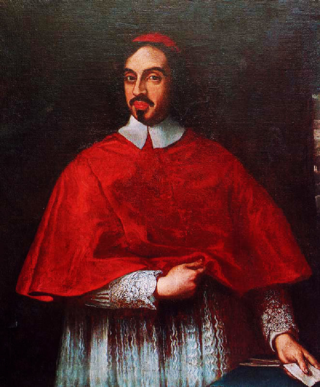
Rinaldo d'Este was an Italian Catholic cardinal.
Girolamo Mattei was an Italian nobleman of the House of Mattei and Duke of Giove.

Asdrubale Mattei, Duca di Giove, was an Italian nobleman of the House of Mattei, an avid art collector and a patron of Caravaggio.